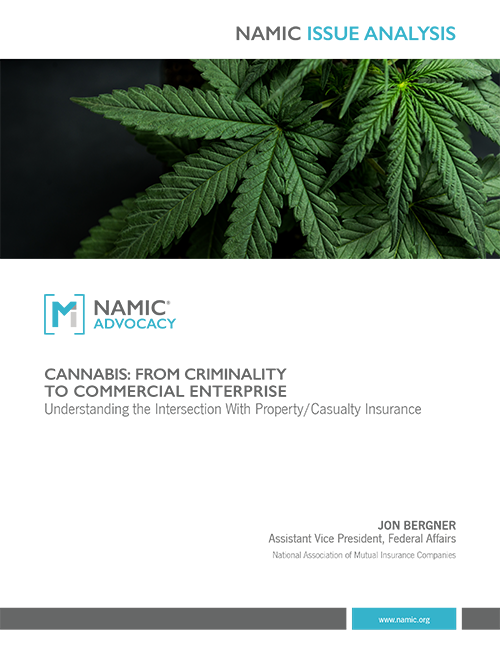Our Positions | Cannabis
NAMIC has begun to explore the widespread ramifications of the explosive and “legal” growth of the cannabis industry over the past decades. While the legalization of marijuana can be a politically divisive subject, there is value in property/casualty insurers developing an understanding of how the issues at play will affect their companies. Given recent trends, it is increasingly impractical for insurers to ignore the rapidly transforming cannabis landscape.
As of March 2019, marijuana is legal for medical use in more than 33 states and D.C., decriminalized in at least 23 states and D.C., and available for recreational use in ten states and D.C. The state legal landscape has shifted dramatically in recent years, and public opinion on the legalization of marijuana has transformed significantly with no sign of relenting anytime soon. However, the fact remains that cannabis continues to be a Schedule I Drug on the federal Controlled Substances Act list. Therefore, it is illegal to assist in its dissemination in interstate commerce, with other federal laws such as RICO allowing for civil penalties as well as criminal charges for assisting in distribution of a controlled substance.
Issues of conflicting law have already arisen in the states that deal with such rudimentary concepts of having an insurable interest and whether you can contractually insure for an “illegal” substance as federally defined. Homeowners, automobile, business, crop, commercial, inland marine, worker’s compensation, product liability, professional liability including Errors and Omissions and Directors and Officers as well as intellectual property coverage and policies all have the potential to face such issues. Whether the issue is owning, selling, prescribing, medicating, growing, transporting, storing, advising, assisting, using, reimbursing or any other concept that can be conceived, insurance and especially the property and casualty lines will be in the mix. Exposure to interactions with the “legal cannabis” industry should be discerned, the risks explored, and risk tolerance assessed. Protection from unwarranted intrusion into underwritten policies, retrospectively and prospectively, is one parameter that is at stake and should be closely evaluated.
Issue Analysis Papers
CANNABIS: FROM CRIMINALITY TO COMMERCIAL ENTERPRISE
Understanding the Intersection With Property/Casualty Insurance (PDF)
A better understanding of why the U.S. insurance regulators and industry cannot agree to an EU-type capital requirement may provide some context for meaningful discussions at the G20, the FSB, Congress, and among other policymakers before such a standard is adopted. In this paper, NAMIC provides background about the U.S. insurance supervisory system and group capital efforts at the IAIS, National Association of Insurance Commissioners, and Federal Reserve to outline the real need for a directional change at the IAIS.
(Published 12/21/18)


